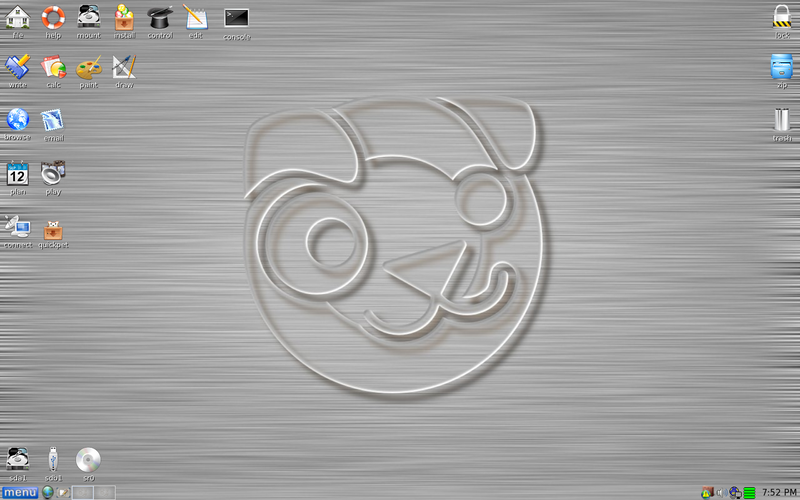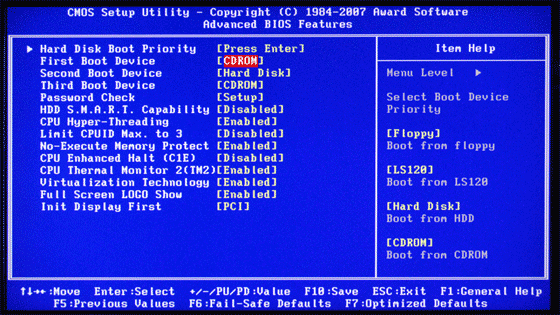No Bootable Device?
Started by
TheN3rdLord
, Nov 14 2013 12:34 AM
#1

 Posted 14 November 2013 - 12:34 AM
Posted 14 November 2013 - 12:34 AM

#2

 Posted 14 November 2013 - 10:24 AM
Posted 14 November 2013 - 10:24 AM

Sounds like the hard drive may be severely corrupted, disconnected somehow or it may have expired. If isn't recognized in the CMOS/BIOS Setup, check to make sure the drive is firmly attached to the motherboard connector. Removing and reinserting it a few times can help clean the contacts. If it's still not seen in the CMOS/BIOS Setup, the hard drive will need to be replaced. (Mechanical hard drives have moving parts. Moving parts cause wear. And once the wear becomes great enough, it's TITSUP, [total inability to support usual performance]). 
Edited by SpywareDr, 14 November 2013 - 10:30 AM.
#3

 Posted 14 November 2013 - 11:20 AM
Posted 14 November 2013 - 11:20 AM

When I open up the system boot menu and move over to the boot tab it displays the HDD's name. I believe that the computer recognizes that it is there, but I'm not sure why my system wont boot up. Is it possible that my hard drive has been wiped clean of everything, including the Operating system? If so, would this be possible to fix? 
#4

 Posted 14 November 2013 - 11:28 AM
Posted 14 November 2013 - 11:28 AM

Fix a wiped Operating System? No. The Operating System could be reinstalled of course, assuming the hard drive is okay.
If you had data on that drive that you "must have", Ontrack, Flashback Data and DriveSavers are three well-known companies that can attempt to retreive files off of a 'dead' hard drive. Pricing typically runs between a few hundred to a couple of thousand dollars (US).
If you had data on that drive that you "must have", Ontrack, Flashback Data and DriveSavers are three well-known companies that can attempt to retreive files off of a 'dead' hard drive. Pricing typically runs between a few hundred to a couple of thousand dollars (US).
#5

 Posted 14 November 2013 - 11:32 AM
Posted 14 November 2013 - 11:32 AM

You can try this to recover files if the drive is not dead and just not bootable. Then we can try to get it to boot after you recover your files. If this or the tools above that SpywareDr noted cannot access the data then you may have to spend some money for professional recovery.
UPDATED April 20, 2012
Use Puppy Linux Live CD to Recover Your Data:
===================
***Required Hardware***
CD Burner (CDRW) Drive,
Blank CD,
Extra Storage Device (USB Flash Drive, External Hard Drive)
===================
1. Save these files to your Desktop/Burn Your Live CD:
2. Set your boot priority in the BIOS to CD-ROM first, Hard Drive Second
3. Recover Your Data
Remember to only click once! No double clicking! Once you drag and drop your first folder, you will notice a small menu will appear giving you the option to move or copy. Choose COPY each time you drag and drop.
YOU ARE DONE!!! Simply click Menu >> Mouse Over Shutdown >> Reboot/Turn Off Computer. Be sure to plug your USB Drive into another working windows machine to verify all data is there and transferred without corruption. Congratulations!

If you're doing this to recover from a virus or malware infection, (or even if you're not), DO NOT copy executable files (.exe, .scr. etc...) if any of these files are infected you could be copying the corruption over to any new device/computer. just copy documents, pictures, music, or videos.
UPDATED April 20, 2012
Use Puppy Linux Live CD to Recover Your Data:
===================
***Required Hardware***
CD Burner (CDRW) Drive,
Blank CD,
Extra Storage Device (USB Flash Drive, External Hard Drive)
===================
1. Save these files to your Desktop/Burn Your Live CD:
- Download Latest Puppy Linux ISO (i.e.: lupu-528.iso)
Download BurnCDCC ISO Burning Software
There are instructions on how to boot from flash drive with puppy here; http://www.pendrivel...e-from-windows/
- Open BurnCDCC with Windows Explorer
- Extract All files to a location you can remember
- Double Click
 BurnCDCC
BurnCDCC - Click Browse
and navigate to the Puppy Linux ISO file you just downloaded
- Open/Double Click that file
IMPORTANT: Adjust the speed bar to CD: 4x DVD: 1x - Click Start

- Your CD Burner Tray will open automatically
- Insert a blank CD and close the tray
- Click OK
2. Set your boot priority in the BIOS to CD-ROM first, Hard Drive Second
- Start the computer/press the power button
- Immediately start tapping the appropriate key to enter the BIOS, aka "Setup"
(Usually shown during the "Dell" screen, or "Gateway" Screen) - Once in the BIOS, under Advanced BIOS Options change boot priority to:
CD-ROM 1st, Hard Drive 2nd - Open your ROM drive and insert the disk
- Press F10 to save and exit
- Agree with "Y" to continue
- Your computer will restart and boot from the Puppy Linux Live CD

3. Recover Your Data
- Once Puppy Linux has loaded, it is actually running in your computer's Memory (RAM). You will see a fully functioning Graphical User Interface similar to what you normally call "your computer". Internet access may or may not be available depending on your machine, so it is recommended you print these instructions before beginning. Also, double clicking is not needed in Puppy. To expand, or open folders/icons, just click once. Puppy is very light on resources, so you will quickly notice it is much speedier than you are used to. This is normal. Ready? Let's get started.
3a. Mount Drives - Click the Mount Icon located at the top left of your desktop.

- A Window will open. By default, the "drive" tab will be forward/highlighted. Click on Mount for your hard drive.
- Assuming you only have one hard drive and/or partition, there may be only one selection to mount.
- USB Flash Drives usually automatically mount upon boot, but click the "usbdrv" tab and make sure it is mounted.
- If using an external hard drive for the data recovery, do this under the "drive" tab. Mount it now.
- At the bottom left of your desktop a list of all hard drives/partitions, USB Drives, and Optical Drives are listed with a familiar looking hard drive icon.
- Open your old hard drive i.e. sda1
- Next, open your USB Flash Drive or External Drive. i.e. sdc or sdb1
- If you open the wrong drive, simply X out at the top right corner of the window that opens. (Just like in Windows)
- From your old hard drive, drag and drop whatever files/folders you wish to transfer to your USB Drive's Window.
Remember to only click once! No double clicking! Once you drag and drop your first folder, you will notice a small menu will appear giving you the option to move or copy. Choose COPY each time you drag and drop.
YOU ARE DONE!!! Simply click Menu >> Mouse Over Shutdown >> Reboot/Turn Off Computer. Be sure to plug your USB Drive into another working windows machine to verify all data is there and transferred without corruption. Congratulations!

If you're doing this to recover from a virus or malware infection, (or even if you're not), DO NOT copy executable files (.exe, .scr. etc...) if any of these files are infected you could be copying the corruption over to any new device/computer. just copy documents, pictures, music, or videos.
#6

 Posted 14 November 2013 - 01:01 PM
Posted 14 November 2013 - 01:01 PM

Thanks for all of your help guys. I really appreciate it. 
#7

 Posted 14 November 2013 - 01:41 PM
Posted 14 November 2013 - 01:41 PM

Hello TheN3rdLord
Let us know if there is any data on the HDD that you wish to back up or if you have successfully backed up your data and would like some additional suggestions.
Let us know if there is any data on the HDD that you wish to back up or if you have successfully backed up your data and would like some additional suggestions.
Similar Topics
0 user(s) are reading this topic
0 members, 0 guests, 0 anonymous users
As Featured On:
















 Sign In
Sign In Create Account
Create Account

